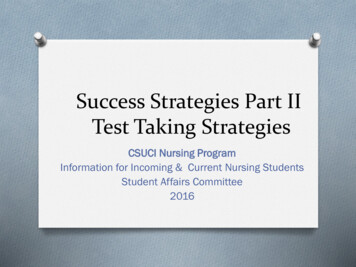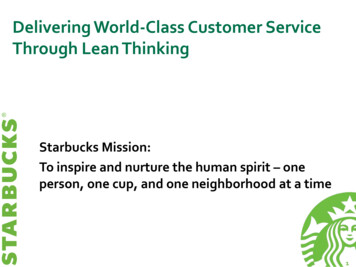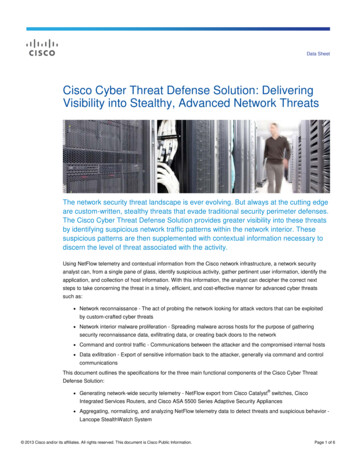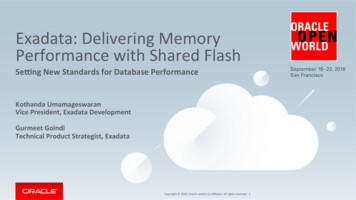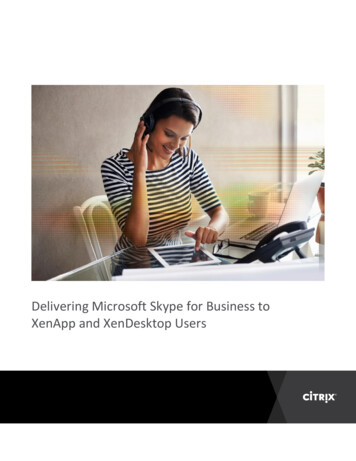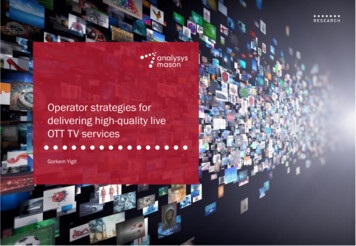
Transcription
Operator strategies for delivering high-quality live OTT TV servicesOperator strategies fordelivering high-quality liveOTT TV servicesGorkem Yigit
Operator strategies for delivering high-quality live OTT TV services2About this reportThis report explores how linear events and live TV channelbroadcasts will form an increasingly significant share of over-thetop (OTT) TV and video services spend worldwide. The reportanalyses the main technical challenges and limitations for pay-TVproviders in delivering live content over-the-top and across variousnetworks.We assess the ability of current and emerging live video deliveryoptimisation and automation technologies across the videodelivery chain to overcome or alleviate two critical servicechallenges, namely scalability and latency, for delivering live OTTvideo services with a high quality of experience (QoE) and highquality of service (QoS).The report also provides recommendations for pay-TV providersthat want to defend their pay-TV propositions against OTTcompetitors and also makes recommendations for vendors activein the video management, delivery and optimisation space.It is based on several sources, including: Analysys Mason’s internal research including pay-TV/OTTforecast data1 interviews with operators and vendor stakeholders in thecontent delivery network (CDN) and video optimisationmarkets.1KEY QUESTIONS ANSWERED IN THIS REPORT What are the main strategies available to pay-TV operators for turningthe live OTT threat into an opportunity? How can pay-TV providers replicate the traditional TV QoE in live OTT?Which of the main challenges need to be addressed urgently? What are the most-important CDN/optimisation strategies andtechnologies that pay-TV providers can adopt to improve QoE/QoS? How can mobile operators manage the negative impact of live OTT inmobile networks? Which are the key CDN, video optimisation and video processingvendors that are providing solutions for high-quality linear OTT TV?WHO SHOULD READ THIS REPORT Vendors that want to gain insight into the drivers and inhibitors ofoperator investment in linear OTT TV services, build their solutionsaround various service strategies and understand other vendors’solutions and positioning. Operators’ chief technical officers (CTOs) and TV/video infrastructureand operations teams that want to understand trends and technologiesin live content delivery and prepare/optimise their video deliveryarchitectures for linear TV services. Operator strategy teams, product managers and pricing teams that areinterested in exploring strategies and models for delivering linear OTT TVservices.For more information, please see Analysys Mason’s Pay-TV services worldwide: trends and forecasts 2017–2022 and OTT videoworldwide: trends and forecasts 2017–2022.
4Operator strategies for delivering high-quality live OTT TV servicesExecutive summaryLinear OTT is a high-growth area of video services spend, butOTT delivery of linear TV content presents unique QoS/QoEissues. Operators and vendors must collaborate on solutionsthat support optimisation and automation across all deliverynetworks in order to successfully deliver linear OTT services.Figure 1: Key issues that pay-TV providers need to consider toaddress linear OTT TV competitionTHE REVENUE OPPORTUNITYThis report examines how pay-TV providers can deliver highquality live OTT TV streaming services to defend and grow theirlive TV propositions. The shift to live OTT services has businessimplications for the following stakeholders:USD5.9billion pay-TV providers, including operators and free-to-air (FTA)broadcasters facing the threat of substitution, direct-toconsumer (D2C) content owners and OTT players; video solution providers such as CDN, headend and OTTservice platform vendors.KEY RECOMMENDATIONSCAGR 17.6%2018–20221USD13billionTHE CHALLENGESIncreased competitionfrom OTT playersand D2C services1. Pay-TV providers should work with vendors to replicatetraditional pay-TV QoE in linear OTT TV with end-to-end,coherent optimisation and automation.ScalabilityandreliabilityLatencyTHE SOLUTIONS2. Operators should use CDN/optimisation capabilities toposition themselves as enablers of live OTT services.3. Vendors should identify opportunities for collaboration acrossand beyond the video delivery chain to address scalability andlatency issues with complete solutions.1Adopt the rightmix of strategicoptionsFor more information, please see Analysys Mason’s OTT video worldwide: trends and forecasts 2017–2022.End-to-endoptimisation andsmart use of CDNsBalance latencyand videoquality
Operator strategies for delivering high-quality live OTT TV services6?Pay-TV providers need to respond to linear OTT competition;replicating the traditional TV QoE in OTT is a major challengeProviders that want to protect and grow their pay-TV businesswith linear OTT propositions need to address the main QoEchallenges associated with OTT delivery of linear content.Linear OTT TV services are growing at a rapid pace, led by OTTproviders’ offers of live TV content (Amazon), as well as contentaggregators’ (Molotov TV) and content owners’ (F1) use of directto-consumer (D2C) models. Pay-TV providers that are aiming tocounter this threat with new propositions face delivery-sidechallenges such as scalability, reliability and latency.1OTT delivery of linear content is more complex in every way thanthe delivery of on-demand content. Consumers have lowertolerance to QoE/QoS degradations and expect their providers todeliver live OTT content with a comparable QoE to the traditionalTV services (such as IPTV, cable, broadcast) that they use. Toachieve this, operators must address several technical challenges: less control over QoE/QoS (including reliability, bandwidth,latency, jitter) when delivering video through unmanagednetworks (Internet); capacity/scalability issues caused by high-peak, popular livecontent (for example, the World Cup) and increasingtraffic/bandwidth; managing any negative impact on – and addressing thespecific optimisation requirements of – mobile networks.1Figure 2: Main delivery-side challenges for replicatingtraditional TV services in linear OTTSCALABILITY (CAPACITY/TRAFFIC MANAGEMENT)AND RELIABILITY15xLive internet video traffic growth from 2016 to20212Russia 2018 World Cup vs. Brazil 2014 World Cup:live streaming traffic and users comparisons3 2x2–3xCDN peak trafficbandwidthNumber of peakconcurrent streams(all devices) 2xNumber of streamsfrom mobile devicesMANAGING THE LATENCY AND VIDEO QUALITY TRADE -OFFTypical OTTlive-stream latencyTypical IPTV/cable TV30–45seconds4–5secondsvs.For example, the Mayweather–Mcgregor boxing match pay-per-view event in August 2017 had serious outages, which resulted in customer class action lawsuits.Similarly, Liberty Media had major service problems in the live streaming of F1 TV in May 2018, as did Optus Sport during a group stage game of World Cup 2018;both resulted in some reputational damage and customer compensations; 2 Cisco VNI; 3 Based on data from Akamai, Edgeware, EE and Openwave Mobility.
Operator strategies for delivering high-quality live OTT TV services7Pay-TV providers need to deploy delivery solutions that canenable them to turn the live OTT threat into an opportunityProviders should work with vendors to replicate the QoEassociated with traditional pay-TV services as much as possibleby implementing a variety of video delivery optimisation andautomation solutions across the video delivery chain.Providers have three main strategic paths for linear OTT delivery,including launching a full-featured OTT linear service; supplementingexisting pay-TV with parcelled offers and pay-per-view (PPV) linearpropositions; and partnering with OTT players. (see section 1 foran overview of these strategies). With each of these options, it iscritical that QoE is at least equal to traditional pay-TV service QoE.To achieve this, operators must have an end-to-end optimisationand automation approach, which ensures that improvements aremade at each stage of the video delivery chain based onoperators’ specific service/network requirements. Key capabilitiesinclude: gaining greater control over QoS by implementingprivate/hybrid, orchestrated CDNs; improving scalability andreliability by implementing CDN/network optimisationtechnologies (multicast ABR, mobile traffic optimisation)and embracing higher software control and automation withSDN/cloud and advanced analytics solutions (see section 2); striking a balance between latency and video quality; reducinglatency to acceptable levels by using techniques for HTTPABR (HLS/DASH/CMAF) and UDP-based optimisation (seesection 3).1Figure 3: Technical requirements for high QoE for liveOTT TVLaunch fullfeatured OTTlinear serviceAim to replicatetraditional pay-TVservice quality1Supplementtraditionalwith OTTCollaboratewith OTT playersHave an end-to-end optimisation and automationapproach across all video delivery networksImprove scalability and traffic management throughthe smart use of CDN technologies and approachesOptimise the balance between latency andvideo qualityReplicating the complete pay-TV experience in OTT will involve providing a comparable service quality as well as delivering similarservice features such as cloud DVR and rethinking monetisation strategies (e.g. advertising). However, operators need toprioritise service quality first before everything else and as such this report focuses on the QoE aspects of OTT delivery.
Operator strategies for delivering high-quality live OTT TV servicesRecommendations123Pay-TV providers should work with vendors to replicate traditional pay -TV QoE in linear OTT TV with end-to-end,coherent optimisation and automation at each step of the video delivery chain.In order for linear OTT TV services to be successful (whether providers’ own services or partner integrations),providers need to deliver a comparable QoE/QoS to traditional pay-TV services. Despite limited control andvisibility with Internet-based content delivery, proper planning, design, automation/orchestration and monitoring ofcomponents and processes across the delivery chain can help providers improve scalability, reliability and latency.Operators should use CDN/optimisation capabilities to position themselves as enablers of live OTT services.Operators must first take advantage of CDN/network optimisation solutions such as multicast ABR and mobilevideo optimisation (traffic management, LTE-B, 5G edge clouds/CDNs) to ensure a high level of QoE for their ownlive OTT services. Operators should then consider creating unique propositions for all other live OTT serviceproviders by enabling them to deliver more-scalable and more-reliable live OTT TV services across all types ofnetwork. Such an approach would elevate operators’ importance in the value chain and create new opportunities.Vendors should identify opportunities for collaboration across and beyond the video delivery chain to addressscalability and latency issues with complete solutions.Increased scalability and low-latency delivery will require the industry to collaborate on developing more-advancedtechnologies, standards, protocols and operational capabilities, as well as multi-vendor interworking in the highlyfragmented video market. Operators will also need to establish new partnerships with vendors outside the traditionalvideo market to deliver automation capabilities such as NFV/SDN, orchestration and AI/machine-learning.8
Operator strategies for delivering high-quality live OTT TV servicesContentsExecutive summaryAnalysis and recommendationsLinear OTT service strategies for pay-TV providersManaging QoE/QoS at scaleReducing live OTT latency for improved experienceAppendixAbout the author and Analysys Mason
Operator strategies for delivering high-quality live OTT TV servicesAbout the authorGorkem Yigit (Senior Analyst) is the lead analyst for the Video and Identity Platforms programme and a contributor to the Digital InfrastructureStrategies and Network Automation and Orchestration programmes, focusing on producing market share, forecast and research collateral. Hestarted his career in the telecoms industry with a graduate role at a leading telecoms operator, before joining Analysys Mason in late 2013. Hehas published research on NFV/SDN services business cases, identity management in the digital economy, and has been a key part of majorconsulting projects including Telco Cloud Index and IPTV/OTT procurement. He holds a cum laude MSc degree in Economics and Managementof Innovation and Technology from Bocconi University (Milan, Italy).43
Operator strategies for delivering high-quality live OTT TV services44Analysys Mason’s consulting and research are uniquely positionedAnalysys Mason’s consulting services and research portfolioCONSULTINGWe deliver tangible benefits to clients across the telecomsindustry: communications and digital service providers, vendors,financial and strategic investors, private equity andinfrastructure funds, governments, regulators, broadcasters,and service and content providers.Our sector specialists understand the distinct local challengesfacing clients, in addition to the wider effects of global forces.We are future-focused and help clients understand the challengesand opportunities that new technology brings.RESEARCHOur dedicated team of analysts track and forecast the differentservices accessed by consumers and enterprises.We offer detailed insight into the software, infrastructure andtechnology delivering those services.Clients benefit from regular and timely intelligence, and directaccess to analysts.
Operator strategies for delivering high-quality live OTT TV servicesResearch from Analysys Mason45
Operator strategies for delivering high-quality live OTT TV servicesConsulting from Analysys Mason46
Operator strategies for delivering high-quality live OTT TV servicesPUBLISHED BY ANALYSYS MASON LIMITED IN SEPTEMBER 2018Bush House North West Wing Aldwych London WC2B 4PJ UKTel: 44 (0)20 7395 9000 Email: research@analysysmason.com www.analysysmason.com/research Registered in England and Wales No. 5177472 Analysys Mason Limited 2018. All rights reserved. No part of this publication may be reproduced, stored in a retrieval system or transmitted in any form or by any means – electronic,mechanical, photocopying, recording or otherwise – without the prior written permission of the publisher.Figures and projections contained in this report are based on publicly available information only and are produced by the Research Division of Analysys Mason Limited independently of anyclient-specific work within Analysys Mason Limited. The opinions expressed are those of the stated authors only.Analysys Mason Limited recognises that many terms appearing in this report are proprietary; all such trademarks are acknowledged and every effort has been made to indicate them by thenormal UK publishing practice of capitalisation. However, the presence of a term, in whatever form, does not affect its legal status as a trademark.Analysys Mason Limited maintains that all reasonable care and skill have been used in the compilation of this publication. However, Analysys Mason Limited shall not be under any liability forloss or damage (including consequential loss) whatsoever or howsoever arising as a result of the use of this publication by the customer, his servants, agents or any third party.
quality of service (QoS). . in live content delivery and prepare/optimise their video delivery architectures for linear TV services. . –Mcgregor boxing match pay -per view event in August 2017 had serious outages, which res


